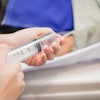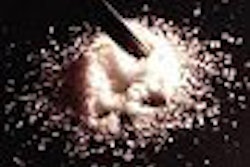There's no reason to delay breast MR after biopsy as the latter procedure does not hamper the modality's sensitivity to cancer size, according to a study in the Journal of Women's Imaging.
MR's high sensitivity does make it an ace imaging exam for breast pathology, but that sensitivity may come with a price -- an overestimation of cancer size or impairment of evaluation because of postbiopsy structural changes, said Dr. Huong Le-Petross and colleagues. Le-Petross is from the University of California, Davis; her co-authors, including Dr. Maitray Patel, are from the Mayo Clinic in Scottsdale, AZ.
The group looked specifically at the time interval between percutaneous core biopsy and breast MR in this retrospective review. They compiled the records of 114 patients in a one-year period. The women underwent contrast-enhanced MR on a 1.5-tesla scanner (Signal LX, GE Healthcare, Waukesha, WI). Stereotactic biopsies were performed either with an 11-gauge vacuum-assisted device or an ultrasound-guided device (14- or 15-gauge spring-loaded device).
The patients were split into two groups: group A included those who had MRI within 14 days of the biopsy, and group B underwent imaging after 14 days. The size of the each cancer was compared on MR and pathology reports. The cut-off point for true-positive (TP), false-positive (FP), and false-negative (FN) MR exams was 10 mm.
Of the 114 patients, 23 with 31 cancers made the final cut. Group A had 17 lesions, while group B had 14 lesions. Overall, there were 29 TPs, two FPs, and zero FNs. In group A, MRI's accuracy rate for cancer size was 94%. The one FP in this group was a 2.5-cm invasive lobular carcinoma, which was seen as a 7-cm area of enhancement.
The accuracy rate in group B was 93%, with one FN attributed to a 2-cm invasive ductal carcinoma with high-grade ductal carcinoma in situ that was seen as a 3.3-cm area of enhancement.
"The results of our study indicate that there was no difference in the accuracy of MR imaging in determining cancer size between two groups of patients subdivided on the basis of time interval following percutaneous biopsy," they wrote (JWI, December 2004, Vol. 6:4, pp. 160-165).
They conceded that their small sample size may have accounted for the similar accuracy rates between the two groups. However, they suggested that any inaccuracy on the part of MRI would be because of specific pathology (MR has been shown to have difficulty detecting and staging invasive lobular carcinoma), and not because of the time interval between imaging and biopsy.
While further research with larger patient populations is needed, the authors stressed that an intentional wait time between the two procedures was not required. Indeed, "MR imaging ... in percutaneously proven breast cancer may play an important role in identifying unsuspected additional sites of cancer in the ipsilateral and contralateral breast," they stated.
By Shalmali Pal
AuntMinnie.com staff writer
March 9, 2005
Related Reading
Breast biopsy costs big bucks, but so does cancer screening, January 19, 2005
Breast MRI still not specific enough to obviate biopsy, December 7, 2005
Copyright © 2005 AuntMinnie.com



.fFmgij6Hin.png?auto=compress%2Cformat&fit=crop&h=100&q=70&w=100)




.fFmgij6Hin.png?auto=compress%2Cformat&fit=crop&h=167&q=70&w=250)











